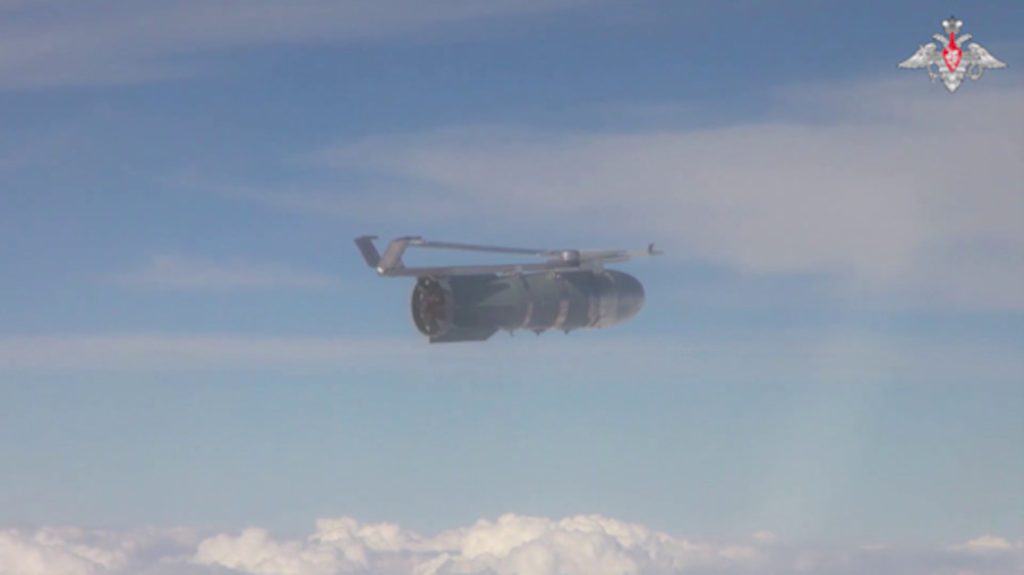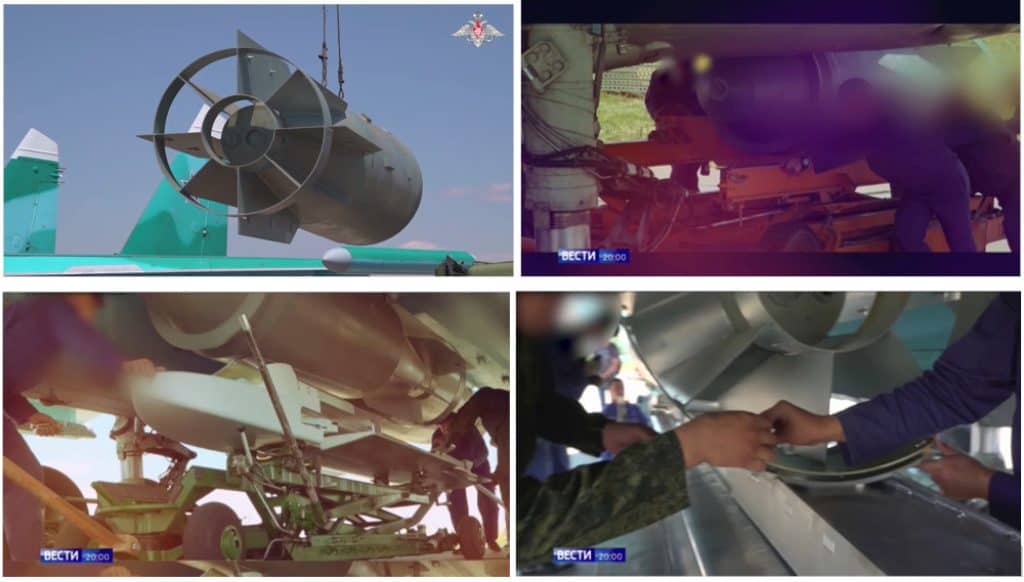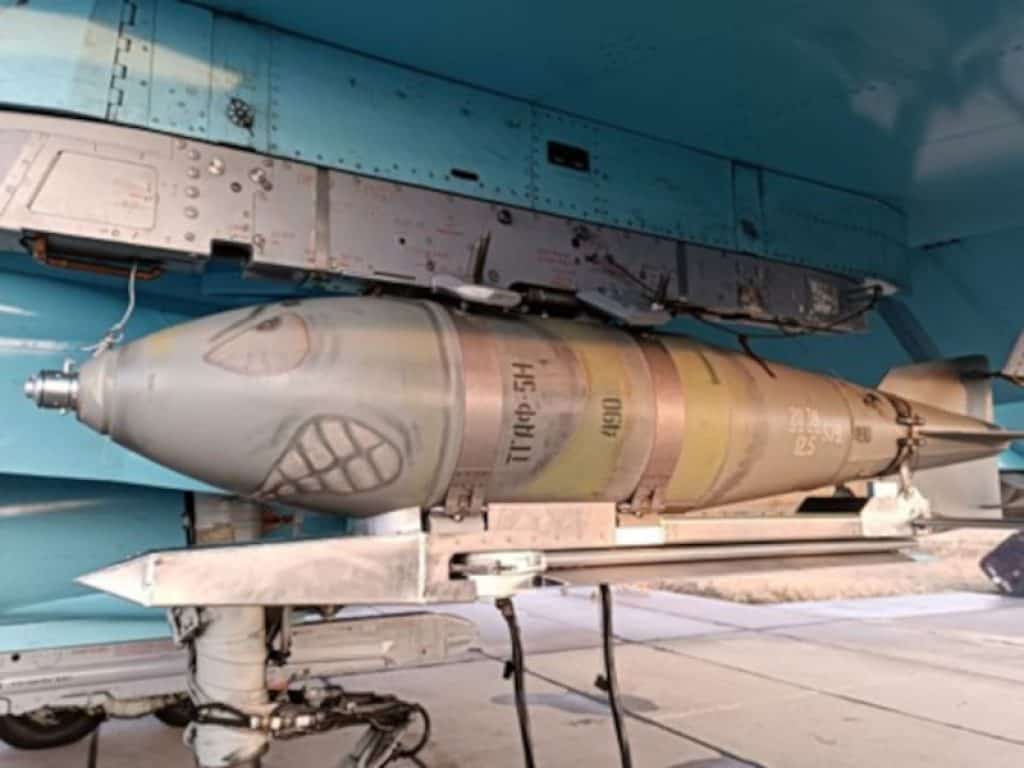
Newly released footage confirms that the Russian Air Force has begun using three-ton glide bombs in Ukraine. While it remains uncertain just how big a role this munition will play in the war, it adds to the large and growing threat that Russian glide bombs pose to Ukrainian forces and civilians.
On July 13 and 14, the Russian Defense Ministry and state media published footage showing a FAB-3000 M-54 bomb being loaded onto a Sukhoi Su-34 strike fighter’s forward centerline station (images shown below). Russian Air Force personnel then fit the bomb with a UMPK (Universal Gliding and Correction Module).

Introduced in early 2023, the UMPK is an inexpensive kit that turns free-fall bombs into guided glide bombs that can be launched from outside the range of most Ukrainian air defense systems. Russia initially employed the UMPK with FAB-500 M-62 high-explosive bombs but later also adapted it for use with various other bombs ranging from 250 to 1,500 kilograms in size. Russia’s Tactical Missiles Corporation, headquartered near Moscow, developed and produces the UMPK.

As expected, the Russians appear to have designed a UMPK kit specially for the FAB-3000, just as they did for 1,500-kilogram-class bombs that first saw use with the UMPK last fall. The UMPK seen on the FAB-3000 resembles the kits used with the FAB-1500 M-54 and ODAB-1500 bombs but is larger and has some other minor differences. To make the FAB-3000 more aerodynamic, the Russians also fitted it with a fairing, as they do with some other UMPK-equipped bombs.

The footage then shows a Su-34 dropping a UMPK-equipped FAB-3000, which begins gliding toward its target after the UMPK’s wings unfold. The Su-34 is also seen carrying two smaller bombs under its wings. The videos then splice in footage previously shared by Russian Telegram channels allegedly showing UMPK-equipped FAB-3000 strikes in northern Kharkiv Oblast.

While Russian Tu-22M3 “Backfire” bombers purportedly dropped some old, unguided FAB-3000s during Russia’s siege of the Azovstal plant in Mariupol in spring 2022, this bomb has seen little use in Ukraine thus far.
In March, however, then-Defense Minister Sergei Shoigu visited the Sverdlov Plant in Dzerzhinsk, where the firm’s general director announced it had put these bombs back into mass production. The Russian Telegram channel Fighterbomber, which has close ties to Russia’s military aviation community and first revealed the UMPK’s creation last year, reported in May that the development of a UMPK kit for the FAB-3000 was almost complete.

On June 20, Fighterbomber and the state-run TASS reported that Russia had begun using UMPK-equipped FAB-3000 bombs in combat. Russian Telegram channels have since shared videos of additional strikes that purportedly used UMPK-equipped FAB-3000s. Almost all those strikes occurred on the Kharkiv front, though it remains unclear whether they indeed employed FAB-3000s or simply 1,500-kilogram bombs. The new footage published on July 13 and 14 provides the first confirmation of the FAB-3000’s employment with the UMPK.
The FAB-3000 M-54 carries a whopping 1,400 kilograms of explosives. It is not hard to see why this would be attractive to Moscow. The Russian Air Force frequently uses UMPK strikes to destroy buildings serving as Ukrainian defensive positions, helping Russian ground troops inch forward. Thanks chiefly to the UMPK, Russia is currently launching around 3,500 glide bombs per month.
At the same time, the FAB-3000’s greater destructive power probably comes at the cost of a shorter range. According to Ukrainian and Russian sources, UMPK-equipped FAB-500 bombs have a maximum range of 60 to 70 kilometers. But TASS, citing a Russian defense industry source, claimed the UMPK-equipped FAB-3000 has a maximum range of 50 to 60 kilometers.
That claim sounds plausible. So far, Russian Su-34s appear to be using UMPK-equipped FAB-3000s to strike buildings within around 10 kilometers of the front line. In the past, Russian Su-34s have typically released glide bombs roughly 35 to 50 kilometers behind the front line. They appear to be doing the same with the FAB-3000, with one video showing a Su-34 releasing the bomb roughly 40 kilometers from the front line. Russian pilots could fly closer to enable deeper strikes, but this would place them under greater threat from Ukrainian air defenses.
Another issue is accuracy. In an appearance on Russian state TV, a Su-34 pilot claimed the UMPK-equipped FAB-3000 has a circular error probable (CEP) of 10 meters. In other words, half of the bombs dropped should fall within 10 meters of their target. But that figure is probably too generous. In many of the videos shared on Telegram, the FAB-3000s damage their targets but fail to achieve a direct hit. Collectively, the footage suggests the CEP is probably in the ballpark of 30 meters. Available data is limited, however, and the accuracy may improve over time as the system is refined.
Low accuracy is one reason some Russian observers have suggested the UMPK-equipped FAB-3000 is impractical. Fighterbomber, for example, has argued that in most cases, the Russian Air Force would be better off dropping larger numbers of smaller bombs. The channel has also called for improving the UMPK’s accuracy rather than trying to compensate for inaccuracy with bigger bombs.
Inaccuracy has also been a problem with smaller UMPK-equipped bombs. But when a Su-34 drops, say, four UMPK-equipped FAB-500s, the chances that at least some will hit the target are higher. The Russians have also sought to improve the UMPK’s accuracy by upgrading its guidance system and making it more resistant to jamming. There are some indications these efforts have paid off. In addition, Russian industry is working on an improved version of the UMPK that will allegedly offer a longer range. Perhaps the new version will be more accurate, as well.
Time will tell how large a role the FAB-3000 will play in Ukraine. Regardless, what is clear is that Moscow is increasingly diversifying its arsenal of cheap, standoff guided munitions—ranging from smaller glide bombs such as the recently introduced UMPB D-30SN to the behemoth FAB-3000.
It is also clear that as the Russian glide bomb threat continues to grow, so too will Ukraine’s need for countermeasures. Additional air defense systems recently pledged by Kyiv’s Western backers will help, affording Ukraine more flexibility to deploy U.S.-made Patriots near the front lines to ambush Russian Su-34s.
However, Ukraine also needs approval to use Western-supplied missiles to strike airbases in Russia. So far, though, the Biden administration remains opposed to this request.







